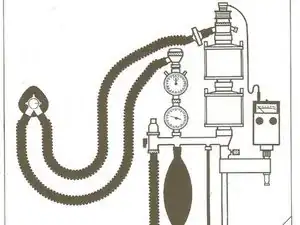Background
The Dräger Circle Absorption System is a critical innovation in the field of anesthesia, designed for recycling exhaled gases to conserve anesthetic gases and oxygen, thereby enhancing operational efficiency and sustainability. This system incorporates several essential components, such as CO2 absorbers, unidirectional valves, breathing bags, and monitoring equipment, all geared towards ensuring patient safety and reducing the environmental footprint of surgical procedures. Its design reflects Dräger's longstanding commitment to innovation, efficiency, and environmental responsibility in medical technology.
Widely adopted across global healthcare settings, the system demonstrates Dräger's pivotal role in advancing medical care. It caters to anesthesiologists and medical professionals, underlining the universal demand for safe and efficient anesthesia delivery systems. While specific data on the number of units manufactured or the system's market price might vary, its global use underscores its relevance and criticality in modern healthcare. Moreover, the system's ability to minimize greenhouse gas emissions by recycling anesthetic gases highlights Dräger's dedication to combining patient care with environmental conservation.
Identification
To accurately identify the Dräger Circle Absorption System, focus on its distinctive layout and components, including the CO2 absorber, unidirectional valves, and breathing bag, which are arranged for efficient operation within its compact structure. This device typically features Dräger's recognizable branding and specific design elements like ergonomic shapes and proprietary connectors, which differentiate it from similar models.
The model number, crucial for obtaining the correct repair information, is located on a label, usually at the back or bottom of the unit. Dräger's equipment often comes in a standard color scheme of whites, greys, or blues, but variations may exist. By noting these key identifiers branding, model number placement, and unique design features users can ensure they are working with the right version of the Circle Absorption System, facilitating successful repairs and maintenance.
Technical Specifications
Given the unique nature of the Dräger Circle Absorption System as a specialized medical device, rather than consumer electronics, its technical specifications focus more on its operational capabilities, safety features, and compliance with medical standards, rather than on hardware specs like CPU and storage capacity. Here’s an outline based on what is generally important for such medical devices:
- System Type: Semi-closed, closed, and semi-open anesthesia system capabilities.
- CO2 Absorption: Features a high-efficiency CO2 absorber to minimize rebreathing and ensure patient safety.
- Valves: Equipped with unidirectional valves to prevent backward flow of gases.
- Breathing Bag: Size and compliance specifications to accommodate various ventilation needs.
- Monitoring Equipment: Includes monitors for vital signs, gas concentrations, and system integrity checks.
- Physical Dimensions and Weight: Compact design suitable for integration with anesthesia machines; specific dimensions and weight vary by model.
- Compliance: Meets global medical safety and performance standards.
- Accessories and Ports: Availability of ports for additional monitoring equipment and accessories tailored to anesthesia delivery and patient monitoring needs.
For the most accurate and detailed technical specifications, consulting the official product documentation or the manufacturer’s website is recommended. Specifications can vary significantly between different models of the Circle Absorption System, reflecting advancements in technology and changes in medical practice standards over time.
Additional Information
Drägersorb® 800+ – Advanced CO2 Absorption
Drägersorb 800+ represents the latest advancement in CO2 absorption technology, specifically designed for use with the Dräger Circle Absorption System. This state-of-the-art soda lime solution is integral to the system's ability to efficiently and safely remove carbon dioxide from anesthesia circuits, ensuring optimal patient care and system performance.
- Summary: Dive deeper into the role of Drägersorb 800+ in enhancing clinical outcomes and operational efficiency in anesthesia systems. As the most current device utilizing the Circle Absorption System, it highlights Dräger's commitment to innovation in patient safety and care cost management.
- Explore Drägersorb 800+ Details
Medical Device Regulatory Standards
Knowledge of regulatory standards is crucial for performing compliant repairs. Links to resources like the FDA provide guidelines on safety and performance standards, ensuring that any device repairs meet legal and safety requirements.
- Summary: Understand the regulatory framework for medical device repairs to ensure compliance and safety in maintenance practices.
- FDA Medical Devices
Academic Insight on Circle Systems and Low-Flow Anesthesia
This article from BJA Education offers valuable insights into the principles, advantages, and considerations of circle systems, including the Dräger Circle Absorption System, which are crucial for anyone involved in their maintenance and repair.
- Summary: Enhance your understanding of circle systems and low-flow anesthesia with this detailed academic analysis, pivotal for informed maintenance and repair practices.
- Circle Systems and Low-Flow Anaesthesia Article
